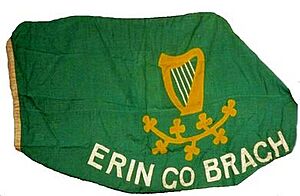Peter O'Connor (athlete) facts for kids
| Medal record | ||
|---|---|---|
| Men's athletics | ||
| Representing the |
||
| Intercalated Games | ||
| Gold | Athens 1906 | Hop, Step & Jump |
| Silver | Athens 1906 | Long Jump |
Peter O'Connor (born October 24, 1872 – died November 9, 1957) was a famous Irish athlete. He was amazing at track and field events. He once set a world record for the long jump that lasted for a very long time. He also won two Olympic medals at the special 1906 Intercalated Games.
Contents
Early Life and Sports Beginnings
Peter O'Connor was born in Millom, England, on October 24, 1872. He grew up in Wicklow, County Wicklow, Ireland. In 1896, he joined the Gaelic Athletic Association (GAA). This group helps promote Irish sports and culture.
By 1899, Peter was already a top athlete. He won All-Ireland medals in the long jump, high jump, and hop, step and jump. For the next ten years, he often beat British athletes in international competitions. He was even asked to represent Britain at the 1900 Olympic Games. However, he said no because he only wanted to represent Ireland.
Setting a World Record
In June 1900, the world record for the long jump was held by Myer Prinstein. He jumped about 7.50 meters (24 feet 7¼ inches). Peter O'Connor started setting his own unofficial world records in 1900 and 1901. He was competing with the Irish Amateur Athletic Association (IAAA).
On May 27, 1901, Peter set an official world record. He jumped about 7.54 meters (24 feet 9 inches) in Dublin. Then, on August 5, 1901, he jumped even further. He reached 7.61 meters (24 feet 11¾ inches) in Dublin. This was the first long jump world record officially recognized by the IAAF.
This jump was a huge deal at the time. It was almost 25 feet (7.62 meters)! His record lasted for 20 years. Only a few other athletes have held a long jump record for longer. These include Jesse Owens, Bob Beamon, and Mike Powell. Peter O'Connor's jump also remained the Irish record for an amazing 89 years.
The 1906 Olympic Games
In 1906, Peter O'Connor and two other Irish athletes, Con Leahy and John Daly, went to the Intercalated Games in Athens. These games were like a special Olympics held between the main Olympic years. The Irish athletes were supposed to represent Ireland. They even had green blazers, caps with a gold shamrock, and an Irish flag. This flag was called the ‘Erin Go Bragh’ flag.
However, the rules of the games changed. Only athletes chosen by official National Olympic Committees could compete. Ireland did not have its own Olympic Committee yet. So, the British Olympic Council said the three Irish athletes were part of the British team. When Peter and his friends signed up, they found they were listed as being from Great Britain, not Ireland.
Long Jump Competition
In the long jump event, Peter O'Connor finally competed against Myer Prinstein. Prinstein was from the U.S. team. Peter had broken Prinstein's world record five years earlier. The only judge for the competition was Matthew Halpin, who was also the manager of the American team. Peter O'Connor worried this might not be fair and protested. But his protest was not accepted.
He kept protesting the judge's decisions during the competition. The distances jumped were not announced until the very end. When they were, Myer Prinstein was declared the winner. Peter O'Connor won the silver medal.
After the competition, during the flag-raising ceremony, Peter protested again. The Union Flag (British flag) was raised for his second-place finish. To show his anger, Peter climbed a flagpole in the middle of the field. He waved the Irish flag while his friend Con Leahy guarded the pole.
Triple Jump Gold
Two days later, Peter O'Connor competed in the hop, step and jump event, also known as the triple jump. He beat his fellow Irish athlete, Con Leahy, to win the gold medal! At 34 years old, Peter was the oldest person ever to win a gold medal in this event. Myer Prinstein, who had won in 1900 and 1904, did not win a medal in this event.
Later Life
Peter O'Connor did not win any more major titles after 1906. However, he stayed involved in athletics his whole life. He helped start the Waterford Athletic Club and was its first Vice-President. He also attended later Olympic Games as both a judge and a spectator.
Peter worked as a solicitor, which is a type of lawyer, in Waterford, Ireland. He was married and had nine children. He passed away in Waterford on November 9, 1957.


